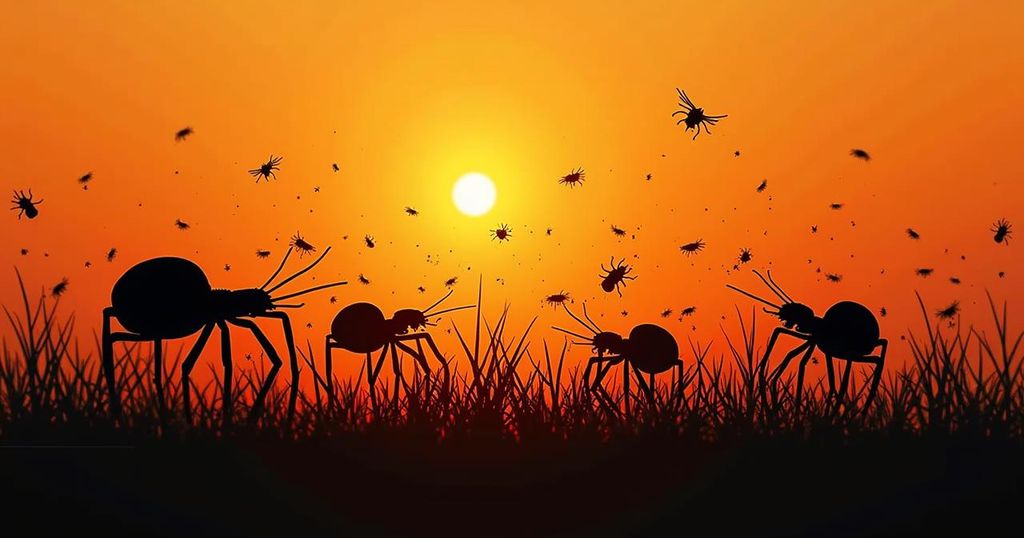The red spider mite scourge in Libya, exacerbated by climate change, is causing significant crop losses in northwestern regions. Farmers report unprecedented damage to fruit and vegetable crops, with the pest’s rapid reproduction linked to increased temperatures and decreased rainfall. Experts urge for integrated pest management and government support to mitigate the crisis.
Climate change is exacerbating the threat posed by the red spider mite, a minuscule yet destructive pest that has resulted in significant agricultural damage in northwestern Libya. These red spider mites, typically measuring less than half a millimeter in size, primarily feed on the sap of various plants, leading to dehydration and the premature dropping of leaves and fruits. Farmers participating in the Wadi Al-Hai agricultural development project report severe infestations this year, which have decimated numerous fruit and vegetable crops. Fathi Al-Tahir, a plant protection specialist with the Ministry of Agriculture and Animal Resources, highlights the deteriorating situation: “The pest was not a big problem in the past… but it has worsened in recent years and has become unprecedentedly brutal, due to climate changes that have clearly affected Libya.” Covering 12,000 hectares, the Wadi Al-Hai project includes over 400 farms that are mainly dedicated to growing figs, pomegranates, grapes, and various vegetables. However, Ashour Suwaisi, coordinator of the agriculture and livestock sector in Garyan municipality, notes that most trees in his jurisdiction have succumbed to the pest, which has now expanded its reach to other cities. Red spider mites, also known as two-spotted mites, have the capability to multiply rapidly under elevated temperatures—conditions that have become increasingly prevalent due to climate change. Formerly contained, these pests have spread into several North African countries since their introduction to the region in the mid-20th century through imported seedlings. For instance, farm owner Jamal Breim recounts his own experience: “The pest first appeared on my farm in 2017, infecting 1,400 fig trees and 1,200 pomegranate trees at an unprecedented speed. Since then, production has become difficult.” Mr. Breim also expressed frustration regarding the ineffectiveness of pesticide treatments owing to their poor quality, attributing responsibility to both the government and international organizations for neglecting the challenges faced by farmers. Suwaisi elaborates on the favorable climate conditions for the red spider mite’s propagation, particularly in the last two years, citing a drastic reduction in annual rainfall from 270 mm to just 50 mm and increased temperatures. These changes hasten the maturation of the mites, resulting in a higher reproductive rate. “In recent years, we have witnessed unusually high temperatures in the spring and autumn, which has increased the spread of [this] and many other agricultural pests,” Al-Tahir pointed out. Experts, including Rachid Boulmatat from the International Center for Agricultural Research in the Dry Areas (ICARDA), caution against the widespread use of non-specific pesticides, warning of the potential for developing pesticide resistance. Boulmatat states, “Many North African countries rely primarily on acaricides to manage pests in fruit and vegetable trees, but there are reports of significant resistance to these pesticides.” In response to the crisis caused by the red spider mites, several experts recommend implementing integrated pest management strategies and enhancing early detection systems. Mohamed Amrani from the UN Food and Agriculture Organization underscores the importance of thorough monitoring and laboratory testing to ensure the quality of pesticides used against these pests. The vast impact of the red spider mite outbreak is becoming increasingly evident, with Abdul Majeed Al-Baghdadi, head of the management committee at Libya’s National Center for Prevention and Agricultural Quarantine, indicating that the pest has spread throughout the country from east to west. Al-Baghdadi noted that a campaign to address the infestation is contingent upon the availability of necessary funding and stable security conditions in Libya.
The article addresses the growing agricultural crisis in Libya, driven primarily by the invasion of red spider mites, a significant agricultural pest that flourishes in arid conditions, exacerbated by climate change. The pests inflict substantial damage on crops, threatening food security in a region that already faces various environmental challenges. The changes in climate, including reduced rainfall and increased temperatures, have created an optimal environment for the rapid reproduction and spread of these mites. Efforts to combat them are complicated by issues such as ineffective pesticide use and the lack of support for farmers facing these modern agricultural challenges.
In summary, climate change is not only transforming agricultural conditions in Libya but is also facilitating the proliferation of harmful pests like the red spider mite. The resulting crop losses underscore the urgency for effective pest management strategies and governmental support to combat this escalating threat. Consequently, specialists advocate for enhanced monitoring, integrated pest control methods, and the need for improved pesticide quality and resistance management to safeguard Libya’s agricultural future.
Original Source: phys.org






